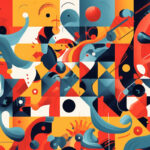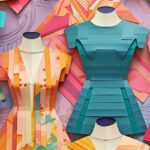As a graphic designer, it’s important to have a solid design library filled with books that inspire, educate, and expand your creativity. In this article, we’ll explore the top graphic design books that every creative professional should have in their collection. From typography to grid systems, and design theory to practical advice, these books cover all aspects of graphic design.

Why Every Creative Professional Needs a Solid Design Library
Design is a discipline that is constantly evolving, and staying up-to-date with the latest trends, techniques, and tools is essential for success. Having a well-rounded design library not only provides inspiration but also allows for continuous learning and growth. The books on this list should be considered a starting point – a foundation for any designer looking to up their game.
The Importance of Continuous Learning in Graphic Design
Graphic design is not a static discipline – it requires constant adaptation and learning. Whether it’s keeping up with the latest software updates, or experimenting with new design trends, continuous learning is essential for staying competitive and relevant. By investing in a solid design library, you’ll have the resources you need to keep learning and growing as a designer.
One way to ensure that you’re keeping up with the latest trends is to subscribe to design blogs and follow design influencers on social media. However, it’s important to remember that not all information found online is trustworthy or accurate. By having a collection of reputable design books, you can ensure that you’re learning from reliable sources.
Expanding Your Creative Toolbox
A well-rounded design library should include a variety of topics and disciplines. In addition to design-specific books, it’s also important to explore topics like art, psychology, and philosophy. The more diverse your reading list, the more tools you’ll have at your disposal when it comes to problem-solving and creative thinking.
For example, reading books on color theory and psychology can help you understand how color affects emotions and behavior, which can inform your design choices. Books on philosophy can help you develop a deeper understanding of aesthetics and the principles of good design. By expanding your knowledge beyond the realm of design, you can bring a unique perspective to your work and stand out from the crowd.
Another benefit of having a diverse design library is that it can spark inspiration and creativity. Reading about different cultures, historical periods, and artistic movements can give you new ideas and fresh perspectives. It’s important to take breaks from your work and immerse yourself in other forms of art and design to prevent burnout and stay inspired.
In conclusion, a solid design library is essential for any creative professional looking to stay competitive and grow in their career. By investing in a diverse collection of books, you can continuously learn and expand your creative toolbox, bringing a unique perspective to your work and standing out in a crowded field.
Top 10 Graphic Design Books for Creative Professionals
As a graphic designer, it’s important to stay up-to-date with the latest trends and techniques in the field. One way to do this is by reading books written by experts in the industry. Here are the top 10 graphic design books for creative professionals:
Thinking with Type by Ellen Lupton
Typography is a fundamental aspect of graphic design, and this book provides a comprehensive overview of the subject. From technical details like kerning and tracking to the historical context of different typefaces, designers of all levels will find value in this book.
For example, did you know that serif fonts are often used in print media because they are easier to read in long blocks of text? Or that sans-serif fonts are more commonly used in digital media because they are more legible on screens?
You can find this book here.
Grid Systems in Graphic Design by Josef Müller-Brockmann
Grid systems are a crucial tool for organizing and laying out designs. This book delves into the theory and practical application of grid systems, making it an essential read for any designer looking to improve their layout skills.
For instance, the book explains how the use of grids can help create a sense of visual hierarchy and balance in a design. By dividing the page into a series of columns and rows, designers can create a structure that guides the eye and helps communicate information more effectively.
You can find this book here.
The Elements of Typographic Style by Robert Bringhurst
Another typography-focused book, The Elements of Typographic Style covers all the intricacies of type, from the anatomy of typefaces to the nuances of different type families. It’s a must-read for anyone who takes typography seriously.
For example, the book explains the differences between serif and sans-serif fonts, as well as the different categories of typefaces, such as old-style, modern, and slab-serif. It also provides guidance on how to choose the right typeface for a particular project or audience.
Logo Design Love by David Airey
Logos are powerful visual tools that can communicate brand identity and values, making them one of the most important aspects of graphic design. This book provides insight into the process of logo design, with real-world examples and practical advice on creating effective logos.
For instance, the book explains how to create a logo that is both memorable and timeless, using examples from some of the world’s most iconic logos. It also provides guidance on how to work with clients to develop a logo that meets their needs and communicates their brand effectively.
You can find this book here.
Don’t Make Me Think by Steve Krug
Usability is a key factor in designing effective websites and digital products. Don’t Make Me Think is a seminal book on the subject, providing practical advice on designing interfaces that are intuitive and easy to use.
For example, the book explains the importance of creating clear and concise labels for buttons and links, as well as the value of using familiar and consistent design patterns. It also provides guidance on how to conduct user testing to identify and fix usability issues.
How to be a Graphic Designer Without Losing Your Soul by Adrian Shaughnessy
This book focuses on the business side of design, exploring topics like branding, client relationships, and career development. It’s a must-read for any designer looking to build a successful career while staying true to their creative vision.
For instance, the book provides guidance on how to build a strong portfolio, negotiate with clients, and manage your time effectively. It also includes interviews with successful designers who share their insights and advice on how to thrive in the industry.
You can find this book here.
The Design of Everyday Things by Don Norman
Good design is not just about making things look pretty – it’s about creating products that are functional, intuitive, and user-friendly. The Design of Everyday Things explores the principles of good design, with practical examples from everyday objects like doors, phones, and light switches.
For example, the book explains how to create products that are easy to use by designing interfaces that are consistent, clear, and easy to understand. It also provides guidance on how to conduct user research to identify and address usability issues.
Making and Breaking the Grid by Timothy Samara
Like Grid Systems in Graphic Design, this book focuses on the theory and practice of grid systems. However, it also explores more experimental approaches to layout, making it a valuable resource for designers looking to push the boundaries of traditional grid-based design.
For instance, the book provides guidance on how to use grids to create dynamic and expressive designs, using examples from contemporary designers. It also explores alternative approaches to layout, such as the use of asymmetry and irregular grids.
You can find this book here.
Interaction of Color by Josef Albers
Color is one of the most powerful tools in a designer’s toolbox, and understanding color theory is essential for creating effective designs. Interaction of Color is a classic book on the subject, exploring the ways in which colors interact with each other and how to use color to create visual impact.
For example, the book explains how to create harmonious color schemes using the color wheel, as well as how to use contrast and saturation to create visual interest. It also provides guidance on how to use color to communicate different moods and emotions.
The Art of Looking Sideways by Alan Fletcher
The Art of Looking Sideways is a more playful and experimental book than others on this list, but it’s no less valuable. Filled with inspirational quotes, images, and exercises, it’s a book that encourages creative thinking and exploration.
For instance, the book provides exercises that challenge readers to think creatively and push their limits. It also includes examples of innovative design and art from around the world, inspiring readers to think outside the box and explore new ideas.
Honorable Mentions: More Graphic Design Books Worth Checking Out
Graphic design is a constantly evolving field, and there are always new ideas and techniques to explore. If you’re looking to expand your knowledge and skills, here are a few more graphic design books worth checking out:
Design as Art by Bruno Munari
This book explores the ways in which design intersect with art, and how design can be used to create meaning and emotion. It’s a thought-provoking read that challenges traditional ideas about design.
Munari argues that design is not just about creating functional objects, but about creating experiences that engage the senses and emotions. He encourages designers to think beyond aesthetics and to consider the psychological and emotional impact of their work.
You can find this book here.
Steal Like an Artist by Austin Kleon
In this book, Austin Kleon encourages readers to stop trying to reinvent the wheel and instead embrace the power of creative theft. It’s a refreshing and inspiring take on the creative process, with practical tips for staying inspired and innovative.
Kleon argues that all creative work is built on the work that came before it, and that the key to originality is not to start from scratch, but to remix and reinterpret existing ideas. He offers practical advice on how to find inspiration, develop your own style, and stay motivated.
You can find this book here.
Creative Workshop by David Sherwin
Creative Workshop is designed as a series of exercises and challenges, each aimed at developing a specific aspect of the design process. It’s a great tool for designers looking to hone their skills and break out of creative ruts.
Sherwin’s approach is hands-on and practical, with exercises that range from brainstorming and sketching to prototyping and user testing. He encourages designers to experiment, take risks, and embrace failure as a necessary part of the creative process.
These books offer a diverse range of perspectives and approaches to graphic design, and are sure to inspire and inform designers at all levels. Whether you’re a seasoned pro or just starting out, there’s always something new to learn in the world of graphic design.
FAQs
What is graphic design?
Graphic design is the ability to creatively pair art and images with text for marketing or publishing purposes.
Why is graphic design useful?
Graphic design is a method of communication that both visual and textual learners can understand. The combination of text and visual aids can help boost the effectiveness of marketing for all audiences.
What are the best books about graphic design?
Grid Systems in Graphic Design by Josef Müller-Brockmann, Thinking With Type by Ellen Lupton, and Logo Modernism by R. Roger Remington are all excellent choices.
- The 11 Best Books About Cats You Should Read - January 16, 2024
- The 9 Best Books on Building Confidence - January 16, 2024
- Discover the 10 Best Books on the Brain - January 16, 2024









